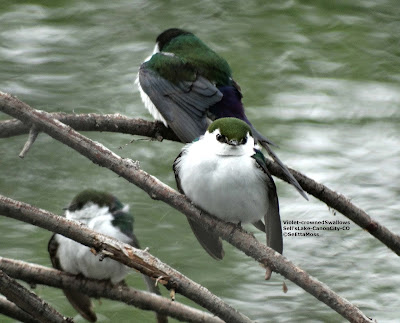Great Kiskadee tongue and more
{note: to see the rest of photos and discussion please click on 'Read More') I rarely get a photo that shows a bird's tongue clearly so I was delighted to find this one provided a nice view of the tongue of a Great Kiskadee, a neotropical species found in the U.S. only in South Texas. I photographed this bird in a water feature at Quinta Mazatlan in McAllen, Tx at the beginning of the month.
The second pic just above also shows the tongue but in a relaxed position. Also notice the 'wiskers' on it's bill--they help guide flying insects into it's mouth.
I added this third pic as it more clearly shows the hook on the end of it's beak (actually on the upper mandible).
While hooks are often used for tearing meat this species usually eats arthropods, mollusks and "...small vertebrates (especially small fish but also tadpoles, lizards, small snakes, and mice)." (Birds of North America online) I guess the hook would help it tear flesh from lizards, snakes and mice. But I wonder if it also is used to securely grasp small fish and tadpoles which would be slippery (and Anhinga use hooked beaks to grab fish to keep them from getting away). If you know please comment below.
This photo is quite good at delineating some of the parts of the bird's wings so I labelled them (at least the first feather in a group). Following are sentences from Birds of North America online (subscription) that describe the feather groups clearly seen here: "Median-coverts margined with rufous. Greater-coverts edged on outer web with rufous... Secondaries and tertials patterned as primaries but with amount of rufous decreasing inwardly." SeEtta
The second pic just above also shows the tongue but in a relaxed position. Also notice the 'wiskers' on it's bill--they help guide flying insects into it's mouth.
I added this third pic as it more clearly shows the hook on the end of it's beak (actually on the upper mandible).
While hooks are often used for tearing meat this species usually eats arthropods, mollusks and "...small vertebrates (especially small fish but also tadpoles, lizards, small snakes, and mice)." (Birds of North America online) I guess the hook would help it tear flesh from lizards, snakes and mice. But I wonder if it also is used to securely grasp small fish and tadpoles which would be slippery (and Anhinga use hooked beaks to grab fish to keep them from getting away). If you know please comment below.
This photo is quite good at delineating some of the parts of the bird's wings so I labelled them (at least the first feather in a group). Following are sentences from Birds of North America online (subscription) that describe the feather groups clearly seen here: "Median-coverts margined with rufous. Greater-coverts edged on outer web with rufous... Secondaries and tertials patterned as primaries but with amount of rufous decreasing inwardly." SeEtta






Comments